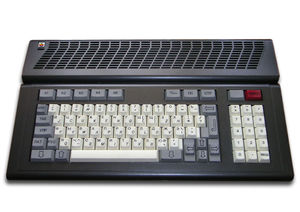Difference between revisions of "Aleste 520EX"
(→Documents) |
(→Pictures) |
||
| Line 57: | Line 57: | ||
File:Aleste PCB Illustrated.gif|PCB illustrated | File:Aleste PCB Illustrated.gif|PCB illustrated | ||
</gallery> | </gallery> | ||
| + | |||
| + | The photos are showing a more or less fully assembled Aleste (the LEDs are missing, and, more important, there is no connection for an internal or external power supply attached to the mainboard). | ||
== Schematics == | == Schematics == | ||
Revision as of 19:23, 2 February 2010
The Aleste 520EX is a clone of the Amstrad CPC 6128 developed 1993 Patisonic in Omsk (Siberia). The Aleste is quite rare. The only existing photos are from http://aleste520.narod.ru]. According to Patisonic themselves, they "produced several dozens of the model, some of them was in 'kit' form".
Additionally to the standard CPC6128 features, it includes a number of additional features: Optional 64-color palette, double color depth (eg. 16 color at high 320x200 resolution), battery-backed Real Time Clock chip, 512Kbyte RAM (of which 192K can be accessed as on 64K CPC with 128K dk'tronics memory expansion), 8bit printer port, expanded keyboard matrix with 10 additional keys, two software controlled LEDs, extended Expansion Port (with additional pins for DMA support).
The computer works with Amstrad CP/M and MSXDOS as well (note: MSXDOS is a CP/M clone, which uses a FAT filesystem, as used on MSX and MS-DOS computers, instead of the normal CP/M filesystem).
Contents
Amstrad Mode
Differences:
- Interrupts can't be manually cleared. This was possible on the CPC by writing to the Gate Array with data bit 7 set 1, bit 6 set to 0 and bit 4 set to 1. In the Aleste this bit is controls an LED.
- Decoding of it's equivalent of the Gate-Array is based on A15 only.
- The Aleste uses a patched CPC6128 Operating System ROM. It is patched to use the Aleste's 8-bit printer port and has a different startup message.
Special Mode
At this mode computer have different memory manager. The manager seems same like MSX mapper and could swicth ON any 16KB page of whole memroy at the any of 16KB page of CPU memory.
The mode have different color coding system. It has the color lookup table (CLUT) or another name pallette. That is dual port memory one prot for coversion pixel's color number to RGB levels. But second for CPU acccess. There is 2 bits for each channel at the pallette present, then it lets to have 64 colors.
The mode have two additional modes with 32KB of video memory. Pixel encoding the same as at Amstrad mode but each line has twice more bytes (and pixels). Two 16KB pages transfer to output, one buffer for odd and second even lines of screen.
The computer have also mc146818 compatible RTC and a 8251 compatible serial. A serial mouse can be used.
The 8253 timer is used to generate transmit and receive clock for serial. In addition the CURSOR output of the CRTC is connected as a trigger which is then connected to the colour hardware. So the CRTC cursor can be used to switch colours by the hardware.
Aleste ROM is 64KB, additional page have BIOS SETUP and MSXDOS Boot Loader.
The BIOS SETUP lets control over: date and time, boot drive, RAM disk, screen mode and style, printer, serial port, and mouse.
At the boot time computer loads BIOS and MSXBDOS (BIOS for Disc BIOS) from a bood disc. After that COMMAND.COM (MSXDOS). Computer can bott from RAM disc as well. Computer go to AMSTRAD mode when "Shift" is pressed while reset.
Magic Sound Expansion Board
Additional sound board MagicSound is a four channel DMA playback. Supports 8 bit per sample, 6 bits of volume per channel, and 16bit samplerate timer per channel. Computer uses the board for playing STM (Scream Tracker) files.
VDP Emulator (is this an expansion board?)
Computer have "GameBios" with is emulator of VDP9938. it was sufficiently - to replace the first several kilos-byte of game and MSX2 game worked. Certainly, video processor MSX is by apparatus sharpened for the games, but they worked sufficiently rapidly to 8MGts of game on "alesta" in order in them to play. Game "FireBird" typical "vertical scroller" worked very well.
Foton Expansion Board
Another additional board FOTON is a "Light Processor". The board have D54 interface and Aleste with special FX application controls over club's light.
Pictures
The photos are showing a more or less fully assembled Aleste (the LEDs are missing, and, more important, there is no connection for an internal or external power supply attached to the mainboard).
Schematics
Documents
- Media:Aleste-Programming-Manual-English.txt - original programming manual (english version, ported to ASCII format)
Technical specs
- CPU: Z80
- Clock: 4Mhz (CPC mode derived from a 16Mhz crystal), 3.2Mhz (Aleste mode derived from a 13Mhz crystal)
- Memory manager: Dk'Tronics compatible memory mapper (CPC mode), msx-mapper (Aleste mode)
- Memory: 512КБ (up to 2МБ)
- Audio: AY8910
- Graphics:
- 256x212:16 colors
- 512x212:4 colors
- 320x200:16 colirs
- 640x200:4 colors
- 640x400:4 colors interleaved
- Palette 64 colors
- Hardware scroll (standard CRTC hardware scroll)
- Floppy disk 3.5"
- Mouse
- RTC (mc146818 compatible)
- Expansion slot
- 19 address lines
- DMA to whole memory
- External board MagicSound
- 4 channels
- 8 bits per channel
- Stereo output
- Touch screen (only prototype)
- Light-Processor with D54
Software
- MSXDOS
- С compiler
- GUI Debugger
- GameBIOS with VDP emulator
- Text editor PowerEdit
- Text files converter TRC. Convert between MSX, Aleste, and DOS
- Disk Fixer (ported)
- Disk Edit (ported)
- Image viewer
- Player of S3M, STM files
- Editor of S3M, STM files
- Games ported from MSX2
- VampireKiller
- KingValery 2
- FireBird
- MetalGear









